FOCUS
Camille Morvan, lab manager de l'IEC
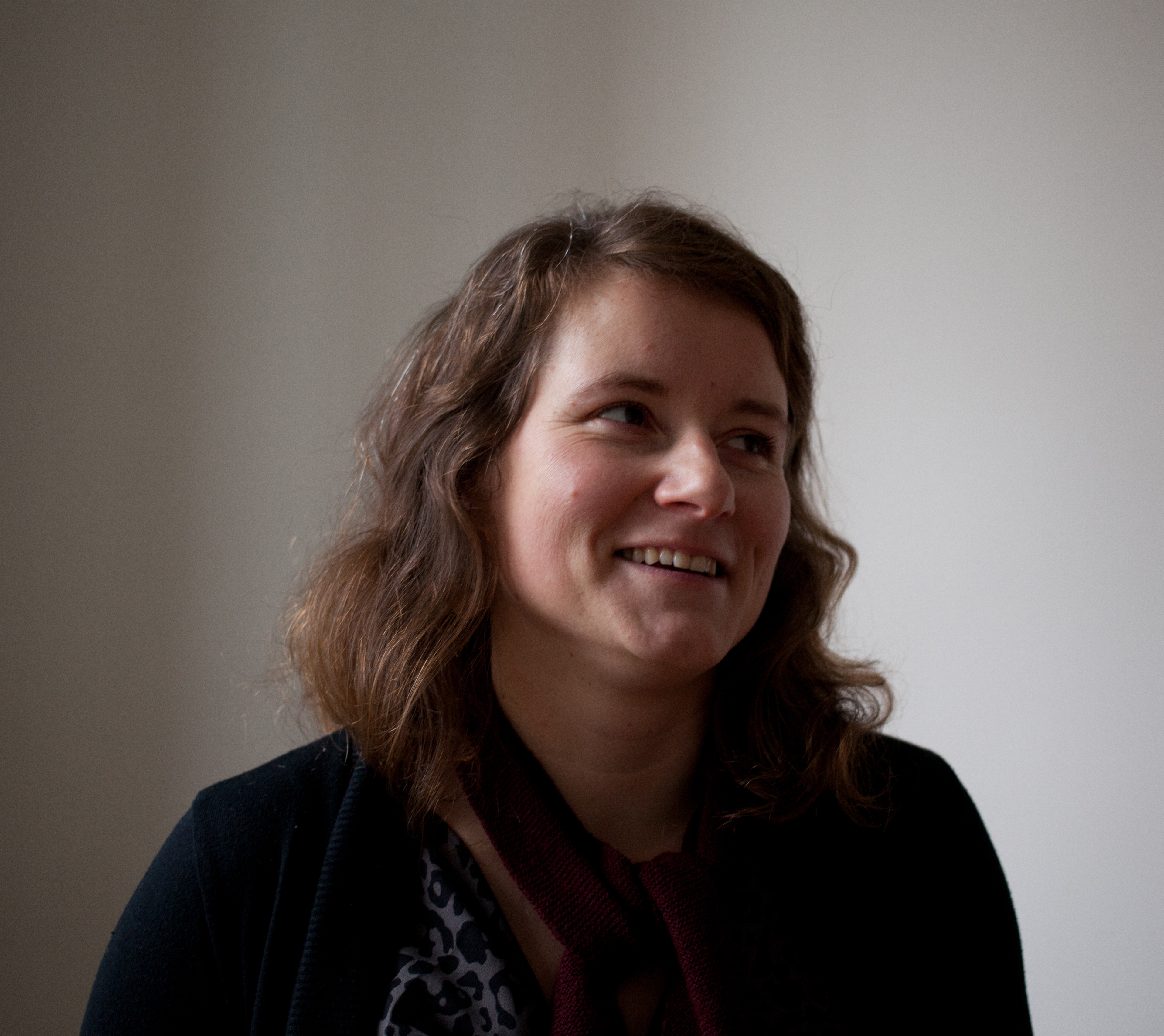
L'équipe administrative et technique de l'IEC s'agrandit avec l'arrivée de Camille Morvan au poste de lab manager.
Camille Morvan a pour mission principale de gérer et d'optimiser les plateformes de recherche de l'Institut.
Après avoir fait une thèse en neurosciences à l'université Paris 6 - elle a travaillé sur la perception visuelle,
la perception de l'espace et la planification du mouvement - Camille Morvan passe du temps aux Etats-Unis, à l'université de New-York puis Harvard
où elle se concentre essentiellement sur des projets autour de la vision.
Ayant fait de la recherche sur la prise de décision, son expertise a été sollicitée dans le domaine des sciences politiques,
du management, et de la biologie.
Camille Morvan entend identifier et développer tout un réseau de compétences et d'expertises au sein de l'IEC.
Neurosciences computationnelles de l’audition

L’Institut d’Étude de la Cognition (IEC) de l’ENS vient de créer une nouvelle plateforme expérimentale au sein de l’équipe Audition (APMN),
ciblée sur l’étude des fonctions auditives. Les recherches qui vont en découler, menées par Shihab Shamma (Chaire Blaise Pascal 2010-2012,
Professeur au Département d’Ingénierie informatique et électrique - Université de Maryland) et Daniel Pressnitzer (Équipe Audition),
seront interdisciplinaires, impliquant à la fois des enregistrements neurophysiologiques avec des animaux en comportement et des modèles
computationnels. Les questions abordées sont liées à des facultés cognitives et perceptives telles que l’attention, la plasticité cérébrale
et la reconnaissance des sons. En effet, l’un des premiers buts est d’explorer, à travers une approche expérimentale,
une perspective radicalement nouvelle de l’audition: l’audition active, qui émerge d’une interaction profonde entre des processus sensoriels
adaptatifs et des processus cognitifs orientés vers un but.
Ce projet de recherche a déjà débouché sur la découverte d’une nouvelle illusion auditive, illustrant l’importance de l’audition adaptative
chez tous les auditeurs. Les futurs travaux serviront à mettre en avant de nouvelles applications, par exemple dans le développement
de solutions apportées aux problèmes auditifs ou pour l'ingénierie numérique dédiée à la musique et au son. Le financement de cette
plateforme a été en grande partie rendu possible grâce à une bourse du Conseil Européen de la Recherche (ERC) attribuée à Shihab Shamma
et Daniel Pressnitzer.
Article publié avec l'autorisation du service de communication de l'Ecole normale supérieure.
Pour plus d’informations:
Institut d’études cognitives, ENS
Équipe Audition : Psychophysique, Modélisation, Neurosciences
Département d’Informatique - Université de Maryland
Laboratoire Psychologie de la Perception - Univ.Paris Descartes/CNRS/ENS
APPELS D'OFFRES
Retrouvez l'ensemble des appels d'offres sur le site web de l'Institut d'étude de la cognition.
FINANCEMENTS
Franck Ramus (Directeur de recherches au CNRS, IEC/LSCP) a obtenu un financement de l’ANR pour le projet DYSEDEN: « Déterminants sociaux des troubles psychologiques et des apprentissages chez les enfants d'âge scolaire ».
PUBLICATIONS
A mutualistic approach to morality
Baumard, N., André, J.B. and Sperber, D., (2013), Behavioral and Brain Sciences, 36, 59-122.
Abstract
What makes humans moral beings ? This question can be understood either as a proximate “how” question or as an ultimate
“why” question. The “how” question is about the mental and social mechanisms that produce moral judgments and interactions, and has been investigated
by psychologists and social scientists. The “why” question is about the fitness consequences that explain why humans have morality, and has
been discussed by evolutionary biologists in the context of the evolution of cooperation. Our goal here is to contribute to a fruitful articulation
of such proximate and ultimate explanations of human morality. We develop an approach to morality as an adaptation to an environment in which
individuals were in competition to be chosen and recruited in mutually advantageous cooperative interactions. In this environment, the
best strategy is to treat others with impartiality and to share the costs and benefits of cooperation equally. Those who offer less than
others will be left out of cooperation ; conversely, those who offer more will be exploited by their partners. In line with this mutualistic
approach, the study of a range of economic games involving property rights, collective actions, mutual help and punishment shows that participants’
distributions aim at sharing the costs and benefits of interactions
in an impartial way. In particular, the distribution of resources is influenced by effort and talent, and the perception of each participant’s
rights on the resources to be distributed.
Neurogenetics and auditory processing in developmental dyslexia.
Giraud, A. L. (Inserm U960, Département d’Etudes Cognitives, Ecole Normale Supérieure / Department of Neuroscience, University of Geneva), & Ramus, F (Laboratoire de Sciences Cognitives et Psycholinguistique, Ecole Normale Supérieure, EHESS, CNRS). (2013). Current Opinion in Neurobiology, 23(1), 37-Volume 23, Issue 1, February 2013, Pages 37–42.
Dyslexia is a polygenic developmental reading disorder characterized by an auditory/phonological deficit. Based on the latest genetic and neurophysiological studies, we propose a tentative model in which phonological deficits could arise from genetic anomalies of the cortical micro-architecture in the temporal lobe.
Genericity
Alda Mari (IJN), Claire Beyssade (IJN), and Fabio Del Prete,
Oxford University Press, 2012
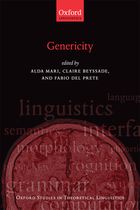
Genericity is a key concept in the study of human cognition, as it reveals our capacity to organize the objects and events of our experience into classes and to detect regularities. In language, it manifests itself both at the level of nominal reference, where the notion of reference to kinds has been central, and at the level of verbal and sentential aspect, where one finds notions such as those of permanency, disposition, ability, habituality, and plurality. The book gathers original contributions from senior and young researchers reconsidering the notion of genericity in its different linguistic realizations. While pursuing the lines of inquiry traced by the influential Generic Book, the authors provide a new look the phenomena and reconsider previous views. The book also provides an up-to-date critical introduction to generics and it will appeal to both students and scholars in linguistics, philosophy, and cognitive sciences.
Abstract Objects and the Semantics of Natural Language
Friederike Moltmann, Oxford University Press, dec.2012
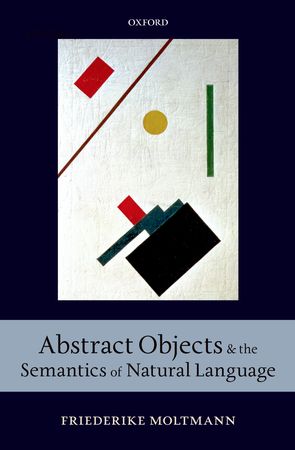
Abstract
Objects have been a central topic in philosophy since antiquity. Philosophers have defended various views about abstract objects
by appealing to metaphysical considerations, considerations regarding mathematics or science, and, not infrequently,
intuitions about natural language. This book pursues the question of how and whether natural language allows for reference
to abstract objects in a fully systematic way. By making full use of contemporary linguistic semantics, it presents a much
greater range of linguistic generalizations than has previously been taken into consideration in philosophical discussions,
and it argues for an ontological picture is very different from that generally taken for granted by philosophers and semanticists a
like. Reference to abstract objects such as properties, numbers, propositions, and degrees is considerably more marginal
than generally held. Instead, natural language is rather generous in allowing reference to particularized properties
(tropes), the use of nonreferential expressions in apparent referential position, and the use of 'nominalizing expressions',
such as quantifiers like 'something'. Reference to abstract objects is achieved generally only by the use of 'reifying terms',
such as 'the number eight'.
Reference to Numbers in Natural Language
Friederike Moltmann, Philosophical Studies 162.3, 2013, 499-536
Abstract
A common view is that natural language treats numbers as abstract objects, with expressions like the number of planets,
eight, as well as the number eight acting as referential terms referring to numbers. In this paper I will argue that this view
about reference to numbers in natural language is fundamentally mistaken. A more thorough look at natural language reveals a
very different view of the ontological status of natural numbers. On this view, numbers are not primarily treated abstract objects,
but rather ‘aspects’ of pluralities of ordinary objects, namely number tropes, a view that in fact appears to have been the Aristotelian view of numbers.
Natural language moreover provides support for another view of the ontological status of numbers, on which natural numbers do not act as entities,
but rather have the status of plural properties, the meaning of numerals when acting like adjectives. This view matches contemporary approaches in
the philosophy of mathematics of what Dummett called the Adjectival Strategy, the view on which number terms in arithmetical sentences are not terms
referring to numbers, but rather make contributions to generalizations about ordinary (and possible) objects. It is only with complex expressions somewhat
at the periphery of language such as the number eight that reference to pure numbers is permitted.
Two Kinds of First-Person-Oriented Content
Friederike Moltmann, Synthese, numéro spécial édité par Philippe de Brabanter et Mikhail Kissine, 184.2, 2012, 157-177.
In this paper, I will argue that two kinds of first-person oriented content are distinguished in more ways than usually thought and
I propose an account that will shed new light on the distinction. The first kind consists of contents of attitudes de se (in a broad
sense); the second kind consists of contents that give rise to intuitions of relative truth. I will present new data concerning the
two kinds of first-person-oriented content together with a novel account of propositional content in general, namely based on the notion
of an attitudinal object. That notion solves two major problems for Lewis' account of contents of attitudes de se and clarifies the difference
between contents of attitudes de se and contents that give rise to intuitions of relative truth. I will propose an analysis of contents of
the second kind in terms of what I call first-person-based genericity, a form of genericity most explicitly expressed by sentences with generic
one. I show how the overall account explains the particular semantic properties of sentences giving rise to intuitions of relative truth that
distinguish them from sentences with expressions interpreted de se. I will start by introducing Lewis' account of attitudes de se and the
problems and go along with that account. Introducing the notion of an attitudinal object, will extend the account by a account of the truth
conditions of the content of attitudes de se. I then discuss the second kind of first-person-oriented content, which is associated with
intuitions of relative truth, and give an account of such contents on the basis of an analysis of generic one. Again making use of attitudinal
objects, I will make clear what exactly distinguishes those contents frol firstperson- oriented contents of the first sort.
Music in
Our Ears: The Biological Bases of Musical Timbre Perception
Kailash Patil, Daniel Pressnitzer (Equipe Audition, IEC, ENS), Shihab Shamma(Equipe Audition, IEC, ENS), Mounya Elhilali. PLoS Comput Biol 8(11), November 1, 2012
Abstract
Timbre is the attribute of sound that allows humans and other animals to distinguish among different sound sources.
Studies based on psychophysical judgments of musical timbre, ecological analyses of sound's physical
characteristics as well as machine learning approaches have all suggested that timbre is a multifaceted
attribute that invokes both spectral and temporal sound features. Here, we explored the neural underpinnings
of musical timbre. We used a neuro-computational framework based on spectro-temporal receptive fields, recorded
from over a thousand neurons in the mammalian primary auditory cortex as well as from simulated cortical neurons,
augmented with a nonlinear classifier. The model was able to perform robust instrument classification irrespective
of pitch and playing style, with an accuracy of 98.7%. Using the same front end, the model was also able to reproduce
perceptual distance judgments between timbres as perceived by human listeners. The study demonstrates that joint
spectro-temporal features, such as those observed in the mammalian primary auditory cortex, are critical to provide the rich-enough
representation necessary to account for perceptual judgments of timbre by human listeners, as well as recognition of musical instruments.
Two dimensions of visibility revealed by multidimensional scaling of metacontrast.
Jérome Sackur (Laboratoire de Sciences Cognitives et Psycholinguistique, EHESS/CNRS/DEC-ENS, Institut d’Études Cognitives, École Normale Supérieure). Cognition
Volume 126, Issue 2, February 2013, Pages 173–180.
Abstract
An increasing number of studies use subjective reports of visibility, so as to delineate the domain of perceptual awareness.
It is generally assumed that degrees of visibility can be ordered on a single unidimensional scale. Here, I put
this assumption to test with metacontrast, one of the most studied visual masking paradigms. By means of multidimensional scaling,
I show that even though metacontrast stimuli only differ along the dimension of time, the perceptual space they generate unfolds in
three dimensions: time and two kinds of visibilities, that are confounded when projected onto a unitary visibility scale.
I argue that metacontrast creates multidimensional complex percepts, a property that may run counter to its use as a simple modulator
of visibility. More broadly the results cast doubt on the use of visibility scales that ignore the qualities of the percepts.
Maximize Presupposition and Gricean reasoning
Schlenker, Philippe: 2012. Natural Language Semantics 20, 4: 391-429
Abstract
Recent semantic research has made increasing use of a principle, Maximize Presupposition, which requires that under certain
circumstances the strongest possible presupposition be marked. This principle is generally taken to be irreducible to standard
Gricean reasoning because the forms that are in competition have the same assertive content. We suggest, however, that Maximize
Presupposition might be reducible to the theory of scalar implicatures. (i)First, we consider a special case: the speaker utters
a sentence with a presupposition p which is not initially taken for granted by the addressee, but the latter takes the speaker
to be an authority on the matter. Signaling the presupposition provides new information to the addressee; but it also follows
from the logic of presupposition qua common belief that the presupposition is thereby satisfied (Stalnaker, Ling Philos 25(5–6):701–721, 2002).
(ii) Second, we generalize this solution to other cases. We assume that even when p is common belief, there is a very
small chance that the addressee might forget it (‘Fallibility’); in such cases, marking a presupposition will turn out
to generate new information by re-establishing part of the original context. We also adopt from Raj Singh
(Nat Lang Semantics 19(2):149–168, 2011) the hypothesis that presupposition maximization is computed relative
to local contexts—and we assume that these too are subject to Fallibility; this accounts for cases in which
the information that justifies the presupposition is linguistically provided. (iii) Finally, we suggest that
our assumptions have benefits in the domain of implicatures: they make it possible to reinterpret Magri’s ‘blind’
(i.e. context-insensitive) implicatures as context-sensitive implicatures which just happen to be misleading.
Temporal and modal anaphora in sign language (ASL)
Schlenker, Philippe. Natural Language & Linguistic Theory February 2013, Volume 31, Issue 1, pp 207-234
Abstract
We suggest that data from American Sign Language (ASL) provide overt evidence for Partee’s and Stone’s claim that natural
language has anaphoric constructions in the temporal and modal domains (Partee 1973; Stone 1997). We provide four arguments.
(i) Like nominal and locative expressions, temporal and modal constructions can establish loci that can then be indexed by
later pronouns. (ii) As is the case in the nominal and locative domains, anaphoric constructions can involve singular, dual,
trial, and plural pronouns. (iii) When the antecedent is existential, patterns of inference obtain which are characteristic
of E-type anaphora. (iv) Finally, temporal and modal anaphora give rise to patterns of ‘locative shift’ which are also found
with geographical locations. The last observation suggests that temporal and modal reference is particularly similar to locative reference.
Cueing Attention after the Stimulus Is Gone Can Retrospectively Trigger Conscious Perception.
Claire Sergent (LPP, UMR 8158, CNRS/Université Paris Descartes), Valentin Wyart (LNC, INSERM U960, IEC , ENS), Mariana Babo-Rebelo(LNC, INSERM U960, IEC , ENS), Laurent Cohen (Université Pierre et Marie Curie-Paris 6, CRICM, UMRS 975), Lionel Naccache (Université Pierre et Marie Curie-Paris 6, CRICM, UMRS 975),
Catherine Tallon-baudry(LNC, INSERM U960, IEC , ENS). Current Biology, Volume 23, Issue 2, 150-155, 13 December 2012
Summary
Is our perceptual experience of a stimulus entirely determined during the early buildup of the sensory representation, within 100 to 150 ms following
stimulation [1,2]? Or can later influences, such as sensory reactivation, still determine whether we become conscious of a stimulus [3,4]?
Late visual reactivation can be experimentally induced by postcueing attention after visual stimulus offset [5]. In a contrary approach from
previous work on postcued attention and visual short-term memory, which used multiple item displays [6,7], we tested the influence of postcued
attention on perception, using a single visual stimulus (Gabor patch) at threshold contrast. We showed that attracting attention to the stimulus
location 100 to 400 ms after presentation still drastically improved the viewers’ objective capacity to detect its presence and to discriminate
its orientation, along with drastic increase in subjective visibility. This retroperception effect demonstrates that postcued attention can
retrospectively trigger the conscious perception of a stimulus that would otherwise have escaped consciousness. It was known that poststimulus
events could either suppress consciousness, as in masking, or alter conscious content, as in the flash-lag illusion. Our results show that
conscious perception can also be triggered by an external event several hundred ms after stimulus offset, underlining unsuspected temporal
flexibility in conscious perception.
COLLOQUIUM DE L'IEC
De 12h à 13h30, 29 rue d’Ulm, 75005 Paris, salle Paul Langevin.
12 mars 2013
Maria Chait: "Discovering patterns in sound sequences".
19 mars 2013
Manos Tsakiris (*LAB* (Lab of Action & Body), Department of Psychology,
Royal Holloway, University of London): "Body-conscious? Yes, but in what way'(s)?"
Consciousness of one’s body is intimately linked to self-identity, the sense of being “me”. A key question is how the brain integrates different sensory signals from the body to produce the experience of this body as mine. Converging evidence suggests that the integration of exteroceptive signals related to the body, such as vision and touch, produces or even alters the sense of self. For example, in the "Rubber Hand Illusion" and the more recently reported "Enfacement Illusion", watching another body being touched synchronously with one’s own produces important changes in the mental representation of one's self. However, multisensory integration conveys information about the body as perceived from the outside, and hence, represents only one channel of information available for self-awareness. Interoception, defined here as the sense of the physiological condition of the body, is an ubiquitous information channel used to represent one’s body from within. How does interoceptive information interact with exteroceptive information to produce the more general awareness of the “material me”? I will present a series of experiments that investigate this interaction and propose a model of the self that relies on the integration of the body as perceived from within and from the outside.
9 avril 2013
Iroise Dumontheil (UCL/ICN): "What is special about social cognition?"
Social cognition studies often employ tasks that involve explicitly thinking about other people’s mental states (theory of mind or mentalising). However, everyday life may require the use of theory of mind in a much more implicit and online way, as well as in combination with executive functions processes of goal management, integration of information, and action selection. Paradigms that combine executive functions and social cognition demands allow the investigation of domain-specific and domain-general behavioural and neural correlates of social and cognitive control mechanisms. I will present a series of studies highlighting the sensitivity of medial prefrontal cortex activity to the manipulation of social information, in contrast with the domain-general recruitment of lateral prefrontal and parietal cortex regions associated with increasing information integration and action selection demands.
30 avril 2013
Uriah Kriegel: "Beyond the neural correlates of consciousness".
One of the most flourishing research areas in the cognitive neuroscience of the past decade has been the search for the neural correlates of consciousness. Yet science is typically interested not only in correlation relations, but also – and more deeply – in causal and constitutive relations. When faced with a correlation between two phenomena in nature, we typically feel compelled to produce an explanation of why the two correlate. The purpose of this paper is twofold. In the first place, I want to lay out the various possible explanations of the correlation between consciousness and its neural correlate – to provide a sort of “menu” of options from which we would ultimately have to choose. Secondly, however, I want to discuss considerations suggesting that, under certain reasonable assumptions, the choice among these various options may be in principle underdetermined by the relevant scientific evidence, in the sense that the traditional metaphysical positions may be strictly empirically equivalent.
Retrouvez le programme du colloquium sur le site de l'IEC.
AGENDA
12e Forum des sciences cognitives
Samedi 30 mars 2013
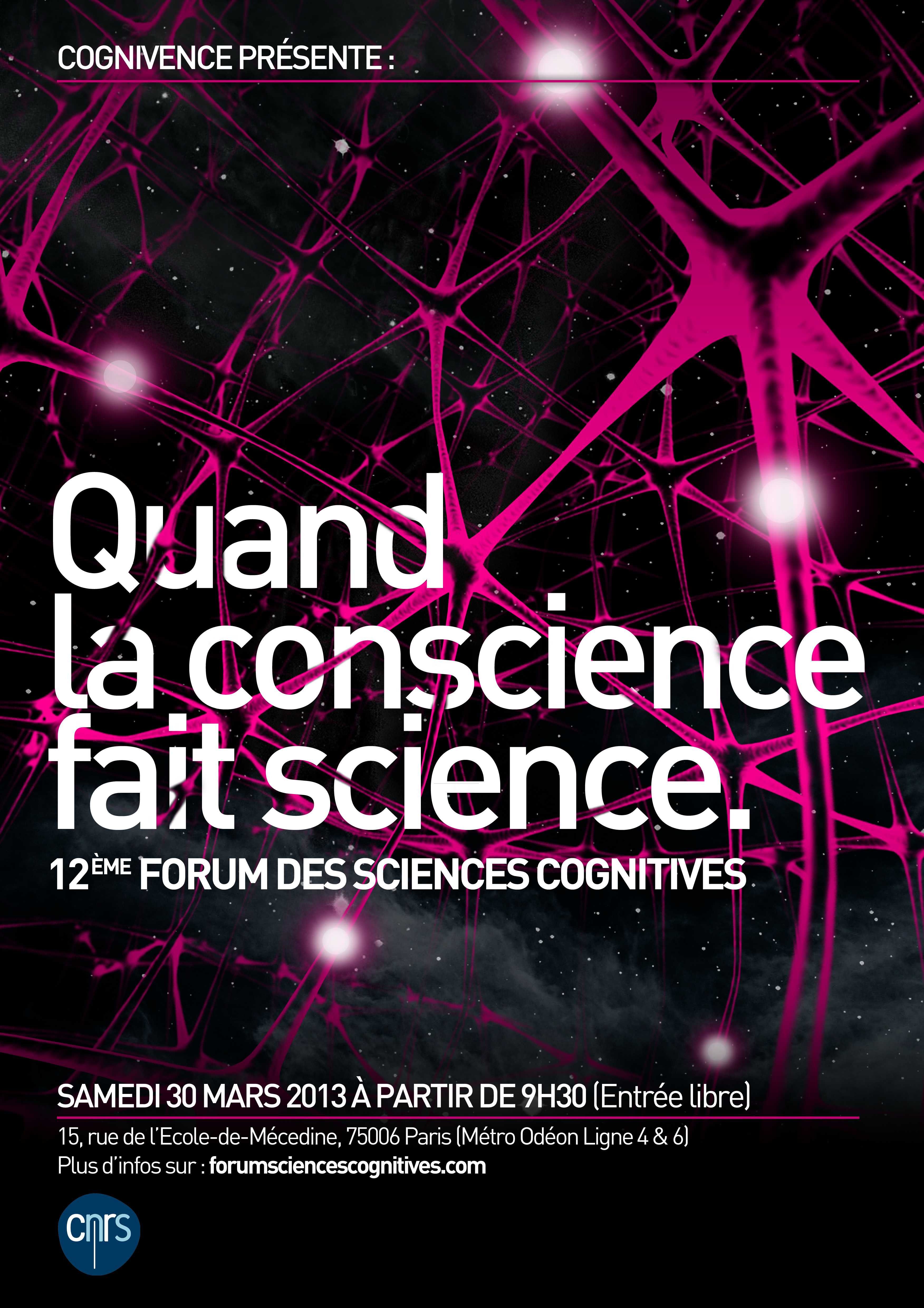
A partir de 9h30 (Entrée libre) au Couvent des Cordeliers
15 rue de l'Ecole de Médecine, 75006 Paris
Métro Odéon Ligne 4 & 10
"Quand la conscience fait science" est le thème de cette douzième édition organisée par l'association Cognivence.
Plus d'informations sur: forumsciencescognitives.com.
Suivez le livetweet #FSC2013 avec @mysciencework.
COLLOQUE - " La psychiatrie et la psychologie fondées sur des preuves."
Samedi 6 avril 2013
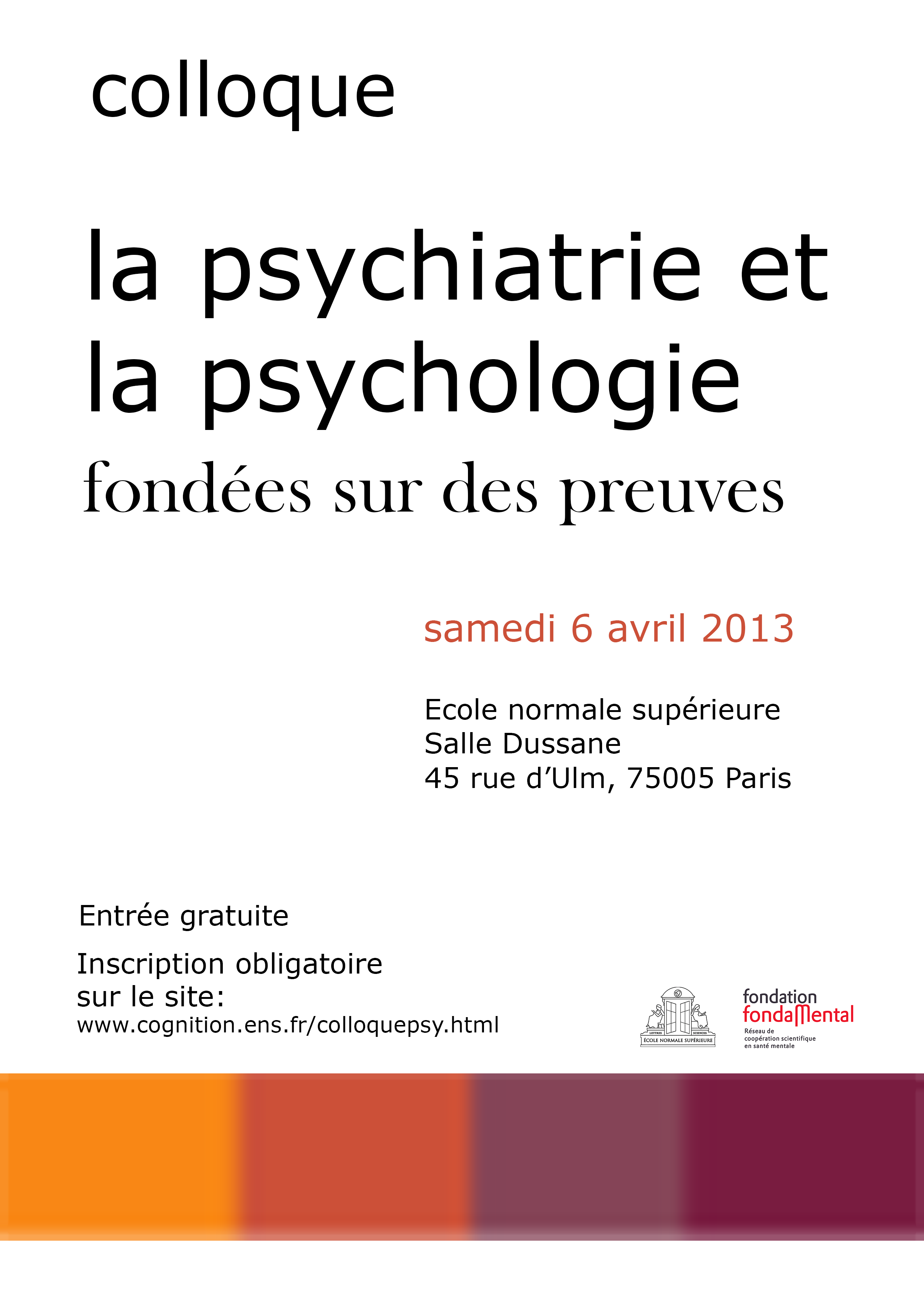
Ecole Normale Superieure
Salle Dussane
45 rue d'Ulm, 75005 Paris
Entrée gratuite
Inscription obligatoire et programme sur le site du colloque
Retrouvez l'intégralité de l'agenda de l'Institut d'étude la cognition sur le site de l'IEC.
